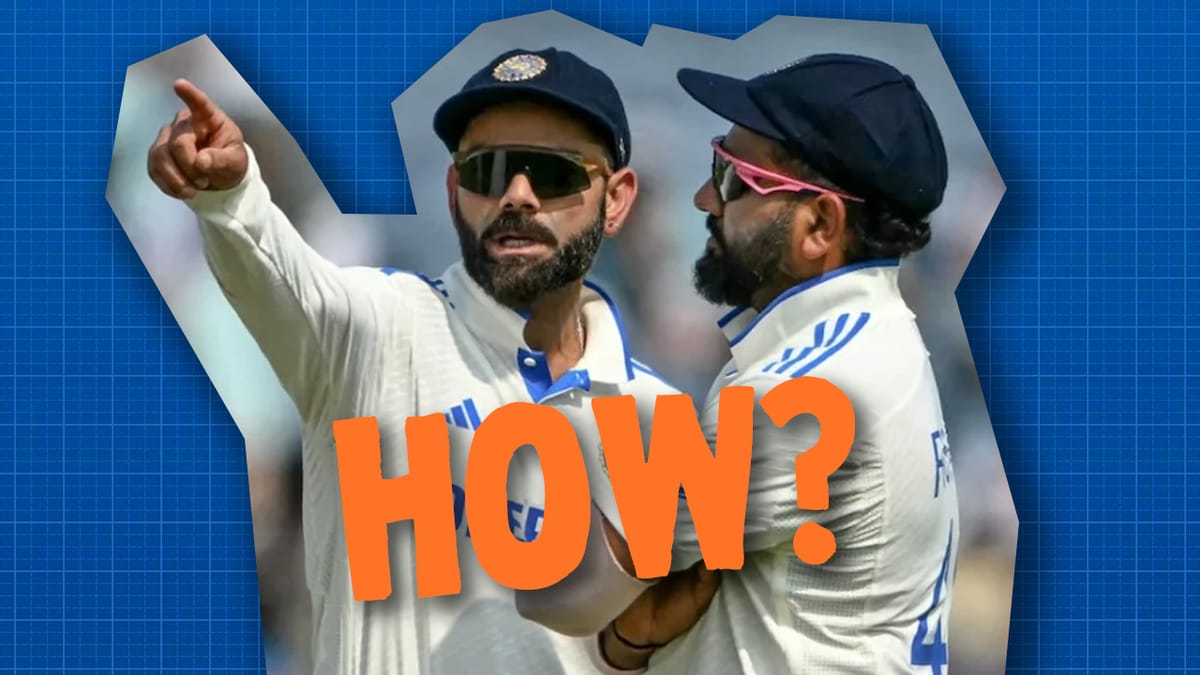How India lose at home

India have lost at home. In fact, they've lost quite a few Tests at home, but this time they lost a series. But I'm actually more interested in the individual losses and what they tell us, because India did not lose a series at home for 4331 days. They have lost six out of 55 Tests since the start of 2013.

India have had one of the greatest runs of all time at home. When we look at dominant home teams in history, West Indies from 1976 to 1995 are right up there. They had seven losses in 62 matches, before Australia broke their streak.
Pakistan beat the West Indies in a Test in 1977 before they're fully formed and are still working out this four-man pace bowling attack. Then they come back in 1988 and draw the three-match series 1-1. Imran Khan basically won them a Test on his own.
However, if you go through all the other losses that the West Indies had in that period, there's one where Allan Lamb just steals a game off them and another where India chased a record 403. But the rest of them are dead rubber games, or when they didn't have their full side because of World Series Cricket. Realistically, I think it's fair to say that the seven losses probably look worse, and they were even more dominant.
We come to Australia, the team that dethrones the West Indies. They actually have two series that are drawn from 1994 to 2008. The New Zealand one is fascinating, because there were no results in a period when Australia were all about results, but the visitors played really good cricket.
Rahul Dravid won a Test match for India in Adelaide, but they didn't have access to Glenn McGrath and Shane Warne in that series. Curtly Ambrose won the West Indies two Tests pretty much on his own. But realistically, the majority of the losses were when the series was already over, much like the West Indies. There were a couple of drawn series, but they were a very dominant team for 84 Tests—winning 63 and losing eight.
You shouldn't play against Imran Khan or Curtly Ambrose. Dead rubbers in those days were often lost, even by good sides. If you didn't have your best players, you were likely to lose. These are the lessons we learn from those two incredible sides.
What about India? I think perhaps the most interesting place to start is Pune. Let's start with the most recent loss. It massively helped tall spin bowlers. In some ways, it's always better to be a tall spinner, but I've never seen the differential be as large as it was in that particular test match.
Another thing that uncharacteristically helped was slower spin bowlers. In India, you usually want faster spinners. When we did our time travel video, that was one of the things we kept looking for—spinners who were specifically fast. Not what you wanted in Pune. The third thing is the reverse sweep. In New Zealand's second innings, the batters were not allowing the bowlers to settle at all.
When Australia won there, that wicket certainly ragged and probably spun more than this recent one. Steve O'Keefe was an unheralded spinner that no one thought much of, and he was absolutely unplayable at times in that innings. Interestingly, he is not tall. I would say that he was a little bit slow, so that might also have played a part.

But you wouldn't really assume that Steve O'Keefe or Mitch Santner would be able to outbowl the Indian spinners. Did that have something to do with the extra slowness? I am not sure. Australia had Steve Smith, and he played an incredible innings in Pune to get them over the line. But he was dropped a bunch of times along the way, so there was an element of India not exactly helping themselves.
It's the same ground, and there are left-arm finger spinners who both come into play. But a few things are a bit different; Kane Williamson didn't even play.
Let's head over to Indore now, which was a wicket where it felt like any spinner was going to have some success on. The thing that really connects these two surfaces is that India just made the wickets spin too much, which actually helped lesser quality spinners. Having said that, Nathan Lyon had learnt how to bowl in India by that stage, and he was fantastic. He did not need Steve O'Keefe by the time he got to Indore.
Even though India didn't set all the many runs, perhaps in other situations they might have been able to put some pressure back on Australia. But Travis Head did Travis Head things while chasing 76 in the fourth innings.
Sometimes, you do get pitches that help seam bowlers in India, but the spinners are fine as well. However, it just did not work for the spinners in Bengaluru. The new ball offered useful swing, which was handy for a swing bowler like Tim Southee. There was also considerable seam movement, which was ideal for a wobble-seam specialist like Matt Henry. The pitch provided both inconsistent and high bounce, which helped with Will O'Rourke in the attack. In many ways, it isn't like the other losses.
This brings us to a couple of England victories, starting with Chennai 2021. India had Ishant Sharma, Jasprit Bumrah, and R Ashwin. But they were missing the partnership between Ashwin and another great spinner, because they didn't have Jadeja in that game and Axar was also injured. They ended up with Washington Sundar, who they didn't understand how to bowl all that much, and Shahbaz Nadeem.
This probably links back to Australia's loss against India in Adelaide, 2003. If you don't have your best bowlers, then you are much more susceptible to losing. On top of that, the toss didn't really go their way. They lost the toss on a wicket where you would want to bat first. Even though the pitch was still fine when they batted in the second innings, it was much better to get the runs on the board early.
They also went up against peak Joe Root, though I am not sure if his most recent peak has gone past this. This is when he made runs in Sri Lanka and a double hundred in this Test. He looked absolutely incredible at that point. India were so far behind that they could never comeback in this game.
The second one was in Hyderabad earlier this year. This was always going to be such a fascinating series, because England had this moral absolute of what Bazball was going to be and how they were going to deal with it.
India kept saying that they are not worried about Bazball. That is how they felt in the first innings of that match, until Pope absolutely destroyed them by playing the reverse sweep again and again in the second innings. Who knows what success England might have had if they played normal cricket? Pope using the reverse sweep was why they had this incredible comeback.
There were other times in that series where they pushed India as well, but India were just a much better side. Other than Root, England don't really bat very well against spin, and they don't have a lot of spin bowlers. Yet, they managed to steal a Test.
The first thing that you notice after going through all the losses is the extreme nature of some of these. Indore in 2023 and Pune in 2017 were really hard wickets to bat on. The last match was brilliant cricket by New Zealand, even if it was very surprising. But the extra help for tall spinners and the slow nature makes that wicket a little bit more extreme, even if it didn't look like it. And Bazball as a concept is as extreme as it gets.
Joe Root's form in 2021, plus the fact that India had a couple of key bowlers missing, meant that they went up against a very, very good batter on what was a flat surface while he was out there. We might never see a pitch like Bengaluru that favours spinners less in India, and also completely complements what the opposition seamers can do in that game.
So, there's no doubt that all of these losses are kind of extreme, which I think is different from what we saw with Australia and West Indies. We saw a couple of great performances by individuals, so of course Root and Smith certainly fit into that. But what we didn't see is a lot of the Steve O'Keefe, Mitch Santner type situations.
When India lose a Test, it tends to be early on in the series when the pressure is still on. So there's also none of the dead rubber stuff that we talked about. They put themselves under extreme pressure to come back and they've managed to do it time and time again. But that takes a lot of energy out of you, and eventually you're just not going to come back.
Notice that I did not really talk about India's batting so far. I focused on the opposition and what they did, the pitches, availability, and India's bowling at times. But batting might be the most important thing.
It's fair to say that a lot of New Zealand's success in this game might have come from Mitch Santner. India played three bad shots at a time when they were pretty much in the game, and had a huge chance of pushing forward. The wickets were going to fall pretty regularly in the second innings anyway. But the pitch was not quite as tough in the first, and giving away three top order wickets to poor attacking shots played a huge part.
India made 105 and 107 against Australia in Pune. It was a pretty low-scoring test, but Australia managed to go past 200 on both occasions. I think we would have to say that batting played a pretty big role in that one. In Indore, they made 109 and 163. Again, it was a tough pitch to bat on. But even if your bowlers are really good, chances are you're losing most games when you make only 272 runs in two innings combined.
What about Chennai? India ended up more than 200 runs behind in the first innings, and Dom Bess took four of those wickets. At that stage, it was still a pretty good wicket to bat on. Bess has played only one match since.
Tom Hartley—who was not picked for England in the recent series against Pakistan—took seven wickets and destroyed India in the chase in Hyderabad. Also, like the latest game in Pune, they gave away wickets when they were massively on top and had a huge chance of winning. That allowed England to make a comeback.
We've done a whole video on how unlikely it is to be bowled out for 46. But ultimately, they were bowled out cheaply. As well as they batted in the second innings, when that new ball changed, they had another collapse.
It's batting. It has always been batting. It's probably been batting in a bunch of games that they have won. We've done videos on how often the lower order has saved them. I do think the extreme nature of some of the pitches has played a part, but they've been terrible at batting consistently. Their bowlers have bailed them out, sometimes with the bat, but usually with the ball.
In Test cricket, India have an incredible batting lineup on paper. But because their wickets are so focused towards bowlers, none of them have any confidence at all and they don't trust what they can do anymore. Generally when you have bad batting, you don't have consistency. India had nothing but consistency for a long period of time, showing what a unique and incredible cricket team they have been.
It won't feel like that right now because you are probably thinking about what Santner did or the 46 all-out, but what India did at home was special. In the history of Tests, cricket teams don't usually do this. When they do, it is not usually finished by someone like Mitchell Santner.




